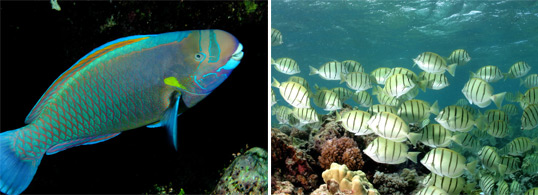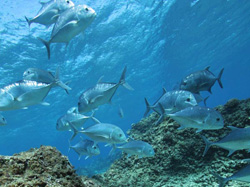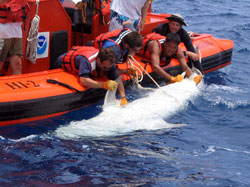
The Link between Algae and Sharks on Healthy Coral Reefs

Apex predators such as tiger sharks are at the top of the food web in Papahānaumokuākea. They are dependent on bottom-dwelling algae as the base of the food web. Credits: James Watt, left; Greg McFall/NOAA, right
What do algae and sharks have in common? They are both end members of the same food web. A recent study of fish populations in Papahānaumokuākea Marine National Monument (PMNM) found that bottom-dwelling (or 'benthic') algae served as the base of the food web, supporting large predators at the top.
Those large predators don't eat algae directly. Rather, sharks and other large fish consume smaller fishes, which in turn eat algae growing on the seafloor (as opposed to microscopic planktonic algae floating in the water column).
For the study, researchers analyzed nearly 600 samples of algae and fishes from the NWHI, including herbivorous surgeonfishes, bottom-feeding predators such as goatfishes and wrasses, apex predators such as jacks and groupers, and several types of sharks, including 14-foot long tiger sharks.

Bottom-dwelling algae, like this new species of red alga (left), Padina sp. (center) and Codium sp. (right), are the base of the food web that supports top predators like tiger sharks. Credit: Greg McFall/NOAA
Scientists examined tissue samples smaller than the size of a pencil eraser and used carbon and nitrogen chemical signatures to determine the relative position of organisms within the food web. The study found that benthic algae represent nearly two-thirds of the production of NWHI ecosystems.
Remote and healthy coral reefs like those in PMNM are unique because they are dominated by high numbers of apex predators, the large carnivorous fishes such as sharks, jacks, and snappers that feed on smaller fishes and invertebrates. Such reefs also have healthy populations of algae. Interestingly, a separate research expedition to Papahānaumokuākea last year brought back several new species of algae, highlighting that while algae are essential for NWHI ecosystems, there is still much to learn about them.
The results of this study have immediate management implications for both healthy reefs like those of PMNM, as well as for more degraded reefs in need of restoration. Since the healthy ecosystems of PMNM were found to be heavily dependent on algae growing on the seafloor, impacts to other such reefs and their algae – like damage from pollution, bottom trawling, or other human-induced threats – could trickle up the food web.

Herbivores such as this spectacled parrotfish (Chlorurus perspicillatus) or uhu uliuli photographed at Laysan Island (left) and convict surgeonfish (Acanthurus triostegus) or manini at Maro Reef (right), graze on benthic algae. Credit: James Watt
NOAA Deputy Superintendent of Papahānaumokuākea Randall Kosaki said the study demonstrates the importance of keeping reefs healthy.
"Anything affecting native algal species, such as sedimentation, dredging or the spread of non-native invasive algae, will ultimately impact the abundance of commercially and ecologically important fishes, such as snappers or jacks," Kosaki said. "Taking care of the reef itself will help to ensure healthy fish populations."

Giant trevally (Caranx ignobilis), ulua aukea, like these photographed at Pearl and Hermes Atoll, eat smaller herbivores and are in turn eaten by larger predators like sharks. Credit: Kyle Nakamoto/Hawaii Skin Diver

Researchers obtain a tissue sample from a tiger shark in Papahānaumokuākea Marine National Monument; the shark was released unharmed afterwards. Credit: Robert Schwemmer/NOAA
The study was a collaborative effort between NOAA's National Centers for Coastal Ocean Science (NCCOS) and the Office of National Marine Sanctuaries (ONMS). Findings were published earlier this month in the scientific journal Marine Biology.
The article, "Evidence for benthic primary production support of an apex predator-dominated coral reef food web," is available online at http://link.springer.com/article/10.1007%2Fs00227-013-2220-x.
Read the Press Release.